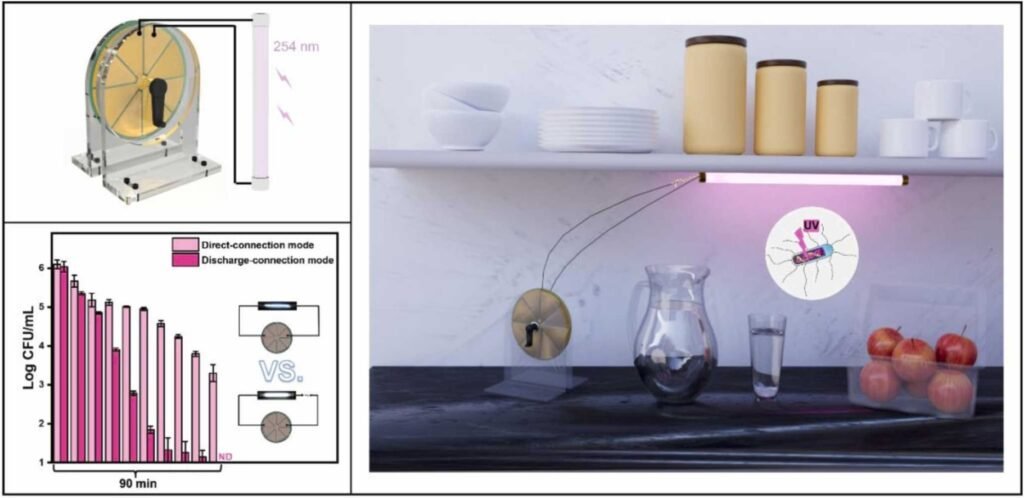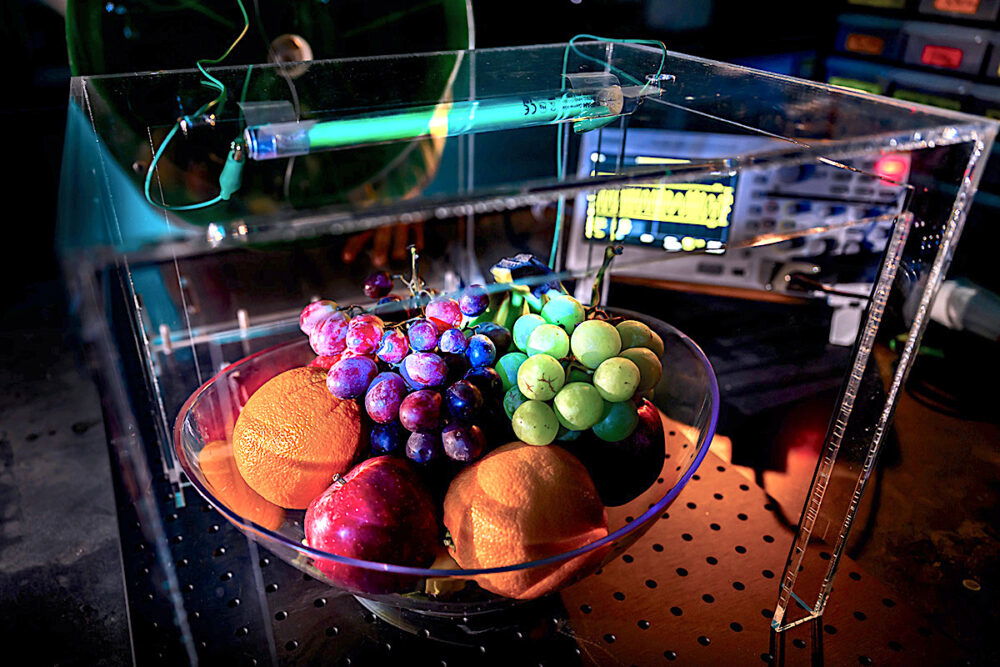Scientists at the University of Illinois Urbana-Champaign have developed the Tribo-sanitizer, a novel ultraviolet-C (UVC) device designed to enhance food sanitization. This portable, self-powered device uses UVC light to inactivate, or kill, harmful bacteria on various food items and surfaces.
Using UVC Light to “Kill” Bacteria with the Tribo-sanitizer
Published in the journal Nano Energy, the Tribo-sanitizer utilizes UVC light, a type of ultraviolet light that falls in the 100-280 nanometer wavelength range. UVC light is known for its germicidal properties, primarily due to its ability to damage the DNA of microorganisms, rendering them inactive or dead. This particular feature of UVC light is what the Tribo-sanitizer leverages to sanitize food items and packaging materials.
In tests, the Tribo-sanitizer has shown significant promise in killing two notorious foodborne pathogens: Escherichia coli O157:H7 and Listeria monocytogenes. These bacteria are responsible for severe illnesses and have been the cause of numerous foodborne disease outbreaks. The Tribo-sanitizer successfully inactivated these bacteria by causing damage to their DNA, and the success rates were astonishingly high.
The device has demonstrated its ability to achieve high levels of decontamination, meeting the stringent sanitization standards set by the Food and Drug Administration (FDA). Certain materials like polyethylene terephthalate (PET), commonly used in food and beverage packaging, achieved a 99.999% reduction in E. coli bacteria. While on food surfaces such as apple peels and romaine lettuce, it achieved reductions of 99.98% and 99.8% for E. coli and 98% for L. monocytogenes, respectively.


Surfaces Matter When It Comes to The Tribo-sanitizer
One of the challenges with the Tribo-sanitizer, and light-based technologies in general, is ensuring complete coverage of the surfaces to be sanitized. This is particularly pertinent for food items with uneven or rough surfaces, where direct exposure to UVC light might be inconsistent. Addressing this issue, the research team suggests incorporating multiple light sources at different angles or combining the Tribo-sanitizer with other decontamination methods.
Another aspect under development is the time required for effective sanitization. Currently, the device takes about 90 minutes to achieve a 99.999% reduction in E. coli bacteria. However, this duration is not viewed as a significant limitation.
“This could be addressed by incorporating other decontamination methods or using multiple light sources at different angles,” study co-author Yi-Cheng Wang, a professor of food safety and engineering, said in a press release. “That is one of the future directions we are working on. And if properly incorporated into existing facilities such as transportation or storage units, the Tribo-sanitizer could potentially provide continuous decontamination throughout the supply chain without the need for commercial power.”
Moreover, this device’s portable and self-powered nature eases some limitations, especially in spaces with limited electricity.
The Tribo-sanitizer harnesses its power from the surrounding environment, transforming mechanical energy, such as movements from humans and wind, into electricity through its triboelectric generator. This ability to utilize what would typically be lost energy is what earns the device its designation as “self-powered,” according to Wang.
In an innovative twist, the device’s design includes an air gap within the triboelectric power source, simulating the action of lightning. This feature works by electrostatically breaking down air molecules, significantly amplifying the Tribo-sanitizer’s power output to over 4,000 volts. As noted in the study, this enhancement substantially boosts the intensity of the UVC lamp used for sanitization.
Why Light is a Cost-Effective Solution to Sanitize Food
The most important implication for this device is its ability to be utilized in remote areas or where access to electricity is limited. According to the World Health Organization, foodborne illnesses affect nearly 600 million people annually, resulting in approximately 420,000 deaths. The mortality and economic costs are significant, but by providing an effective and easily deployable means of sanitizing food, the Tribo-sanitizer represents a novel approach to alleviating these problems.
Additionally, its self-powered nature makes it easy to ship globally, and its low estimated material cost, running at about $70, makes the Tribo-sanitizer a viable option for use in low-resource settings, such as areas affected by natural disasters or conflict zones, as well as the developing world where foodborne bacterial outbreaks are deadly.
MJ Banias is a journalist and podcaster who covers security and technology. He is the host of The Debrief Weekly Report and Cloak & Dagger | An OSINT Podcast. You can email MJ at mj@thedebrief.org or follow him on Twitter @mjbanias.

